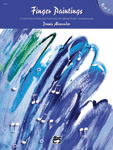
Finger Paintings, Bk. 1 "Was the piano teaching world ever as fortunate as we are today to have a composer like Dennis Alexander? His writing is magical and, like all the other fine composers reviewed herein, he just seems to get better and better! I doubt if there was ever a child who did not love to finger paint! For the young pianist, Alexander's delightful Finger Paintings books are sure to please. From the dazzling finger painting cover to the illustrations on each page, the imagination is bound to soar to that childhood time of finger painting. And pieces with titles like "Chocolate Fudge Swirls," "Giggle Bugs," and "Pagodas in the Mist" conjure up the wonderful motions the young child enjoys so much when finger painting. Book One is a treasure of pedagogically sound pieces for the young beginner. All the pieces are in five finger patterns divided between the hands, a keyboard picture always shows the five finger pattern(s) of each piece and the first three pieces have no eighth note rhythms. Not having eighth notes in several pieces is a bonus for those teachers who prefer to delay eighth notes in the early stages of learning. Another plus is that the pieces are mostly hands separate. There is one piece in 5/4, one in 6/8 and one that uses the dotted quarter followed by an eighth note. No key signatures are used.-----Dr. Martha Baker-Jordan, The California Music Teacher magazine. |

Finger Paintings, Bk. 2 Book 2 does not show the keyboard picture even though the pieces are in five finger patterns. The pieces are progressively more difficult with more involved rhythmic patterns and more use of eighth notes. As in Book One, the last piece is in 6/8 time. In addition to all the pieces being superb, musical solos, the optional teacher duets are absolutely marvelous and add so much color, sophistication and fullness. Alexander's use of harmony is so lovely and will add depth to the experience the young child will have playing duets with a teacher or anyone willing and able to play the duet part. Finger Paintings will correlate beautifully with any beginning method. Book Three has also been published but, unfortunately, was unavailable for this review." -----Dr. Martha Baker-Jordan, The California Music Teacher magazine. |

24 Character Preludes "This exciting collection of preludes contains a wealth of pedagogical challenges for the late intermediate to early advanced level student. The sequence of the preludes is in all major and minor keys, the major key followed by its parallel minor. Alexander composes in a wide range of style in this collection of pieces. He said himself that "the sounds of Bach, Mendelssohn, Schumann, Rachmaninoff, Debussy, Ravel, Gershwin, Prokofiev and Copland are echoed in these pieces." Each prelude could stand alone or the set could be played as an entire cycle. Most of the preludes are 1-2 pages in length and each addresses a specific focus of one or more pianistic problems for the performer. Alexander creates an atmosphere of adventure and excitement through titles such as: Morning Glories, On Majestic Peaks, Opening Act and Thunderflash! Others are more intimate and sentimental, expressing much emotion as in: Longing, Melancholy Evening, Regrets and Solemn Decree. I have had the privilege of hearing Alexander perform his own works in California and, to my delight, a CD of his performance of the 24 Character Preludes is included in this set. It is a wonderful teaching tool in helping students understand what the composer had in mind for the performance of his compositions. These preludes are a great learning tool for helping early advanced pianists prepare for the larger-scale repertoire." ----- Diana Fernandes, California Music Teacher magazine. |
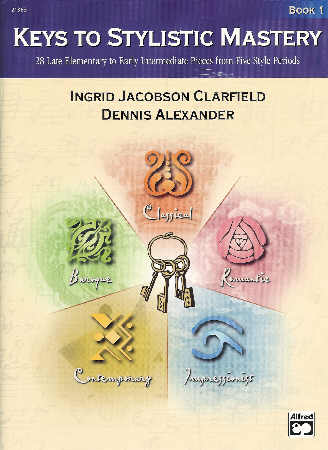
Keys to Stylistic Mastery, Bk. 1 by Ingrid Jacobson Clarfield and Dennis Alexander "This book has 28 solos from the major music eras in addition to original pieces by Alexander for each of the styles; his impressionistic pieces are excellent. This book is full of useful information for teachers and students about the melodies, rhythm, harmonies, tempos, textures, technique, dynamics, expression, ornaments, and pedal for each time period. Details about the pieces will help eighth grade or junior high students to understand more about the music. Students never play more than a seventh, which is helpful because many young pianists at this level still have small hands. There is a short biography about each composer as well as a glossary of terms." -----L.Z., Clavier magazine |
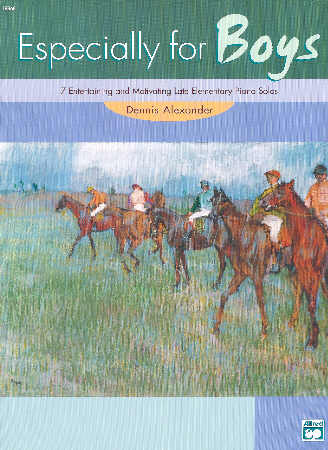
Especially for Boys and Especially for Girls (Reviewer's Choice) "Alexander is the composer of many pupil saving pieces, especially for boys, and now he has a collection with that title. Boys usually crave pieces similar to these with strong rhythms and big sounds. These explore the keyboard and unexpected harmonies to add excitement and motivate students to practice. Along with all the energetic and fast pieces there is a reflective, lyrical solo, recognizing that all students enjoy expressing different moods. In the spirit of equality, Alexander composed Especially for Girls after the book for boys. These pieces also encompass a wide piano range, giving students the opportunity to create big sounds. The varied solos include lyrical, tender pieces, a boogie, and an intense big sounding piece titled "Astronaut Wannabe." Students can explore the variety of material to find a favorite." -----S.H., Clavier magazine |

Folk Song Portraits (Reviewer's Choice) "Even if you or your students do not enjoy folk songs, these arrangements will captivate teacher, student, and listener. Alexander has a gift for creating beautiful, fresh, and varied duet settings, and this collection is no exception. The pieces sound much more difficult than they are, and so will appeal especially to adult players and high school students at the lower-intermediate level. The harmonies are fresh, the occasional contrapuntal lines intriguing, and the arrangements pianistic and easily readable. Any one of these eight selections will provide instant musical satisfaction." -----J.M., Clavier magazine |
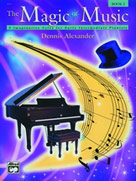
The Magic of Music, Bk. 1 "Every late-elementary student should find a magical, musical moment in at least one of these pieces, which succeed in captivating and inspiring students. "Right Uptown" and "Got Those Boogie Blues" are energetic and rhythmic, and for those desiring a more reflective mood, "Sometimes" and "Laguna Breeze" will appeal. Easy keys and thoughtful writing make this a collection of pieces that students will enjoy and learn easily." -----S.H., Clavier magazine |
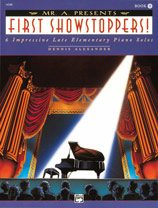
First Showstoppers (Mr. A Presents series) This collection belongs on every teacher's list of pupil-savers for late-elementary students. Alexander includes fast, rhythmic, and big-sounding pieces that will impress students and audiences alike. The forearm clusters and glissandos in "Neanderthal" should encourage students to work on the volume's one contemporary solo. Perfect for students with small hands, the six solos in this collection lie almost exclusively within five-finger hand positions." -----M.B.M., Clavier magazine |
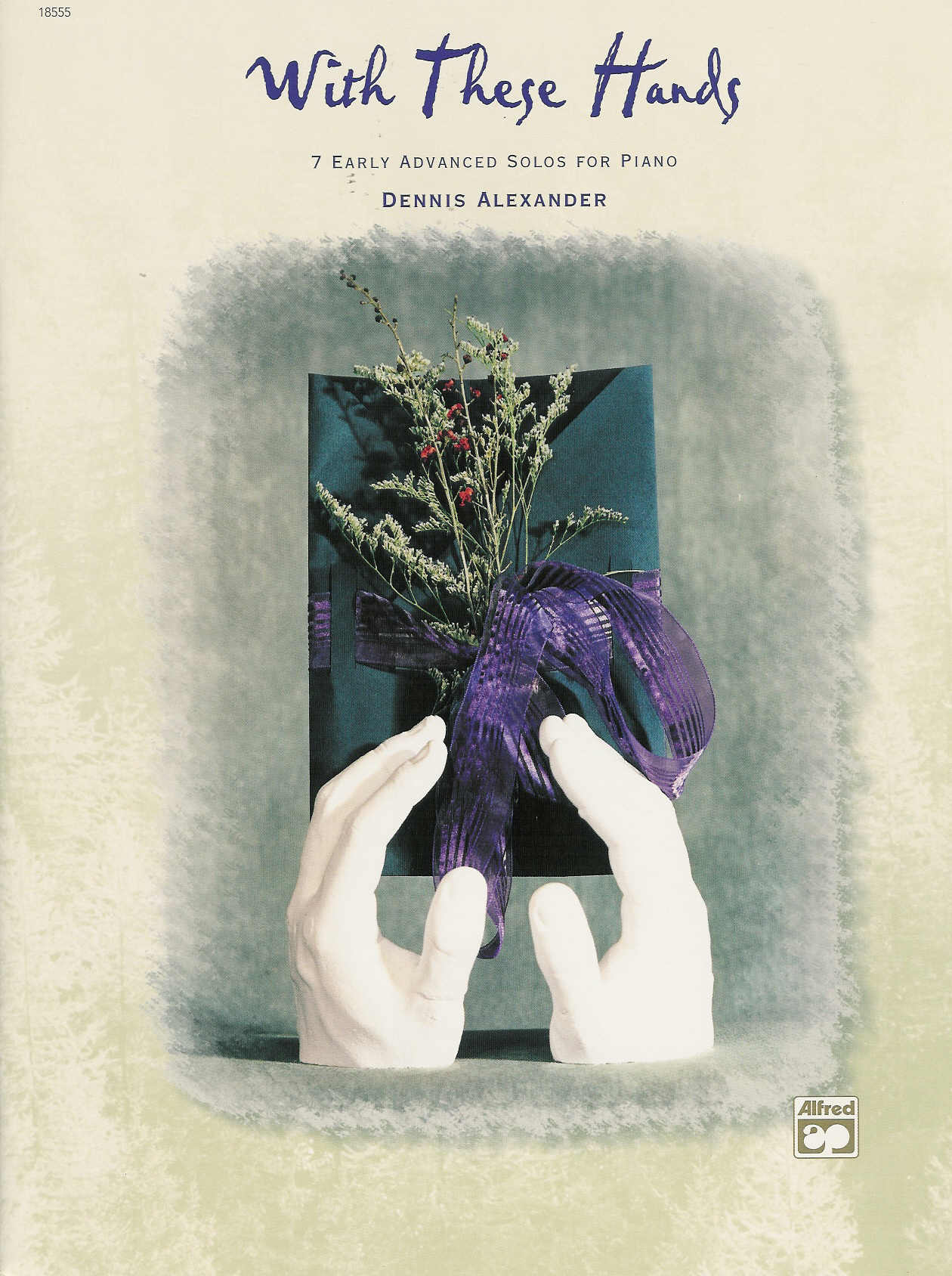
With These Hands "Dennis Alexander wrote the following in the Foreword of With These Hands: "This collection of pieces was written close to a year following the very unexpected and untimely death of my handsome and talented son, Darren Andrew Alexander,"...The following collection is a musical tribute to the life of a very special young man..." There are seven pieces in this outstanding, tender, emotional and sentient offering of the best of Alexander. His immense talent as a composer is nowhere more evident than here where the finest composing he has done is immediately evident! Each piece is lovingly and skillfully crafted. The titles of the more reflective pieces are portrayed with the use of beautiful tone colors, warm harmonies and impressionistic hints here and there. The gentle, yet expansive "Topaz Nocturne" is so poignant it captured my heart and soul on first hearing. The most robust pieces, "Dolphin Quest" and "Best Buddies," are energetic and full of life. Mr. Alexander says that the final piece, "Forever In Our Hearts" represents an "epilogue that would, in essence, summarize my feelings of love for Darren and loss over his untimely departure." For any student at this level, or teachers who love the composing of Dennis Alexander, all the selections in With These Hands should be explored in depth. The "Performance Notes" on the last page (by Alexander) give additional meaningful and helpful insights for the imagination needed to perform these pieces successfully. They are technically and musically challenging but, as always, very pianistic and accessible. Finally, Dennis Alexander is a superb pianist! The CD is absolutely wonderful and includes his "Planet Earth" and seven other pieces, all played with equal aplomb!." -----Dr. Martha Baker-Jordan, The California Music Teacher Magazine |

Simply Sensational, Bks. 1 & 2 "Alexander again provides teachers with effective teaching solos that sound impressive but make limited technical demands. The 13 well-crafted and musically appealing selections can provide rewarding supplementary material for elementary to intermediate students of any age." -----J.M., Clavier magazine |
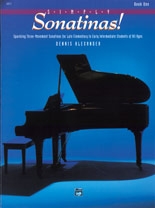
Simply Sonatinas, Bk. 1 "These three sparkling late-elementary sonatinas will delight students of any age. Alexander achieves maximum results with minimal notes, producing tuneful, pianistic pieces with interesting rhythms and pleasantly surprising harmonies. The brevity of individual movements should encourage students to master each sonatina in its entirety, whetting their appetites for sonatinas by Clementi and Beethoven." -----J.M., Clavier magazine |

Just for You, Bks. 1-3 (Reviewer's Choice) "Dennis Alexander's music continues to grow in quality and in its appeal to teachers and students. His work is fresh, pianistic, and, above all, strongly musical; the selections in these volumes are certainly no exception. The three books progress in difficulty, each book containing a variety of styles from slow, lyrical ballads to jazzy, upbeat tunes. Most of the solos are two pages long. This music will inspire and motivate students and is suitable for elementary through intermediate players of any age." ----- J.M., Clavier magazine |
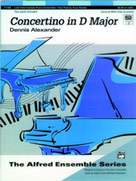
Concertino in D Major "Alexander continues to write music that motivates precollege students, using the medium of two pianos, four hands or piano soloist with a general MIDI disk that includes the background second piano accompaniment as well as the solo piano recording. The music is in one movement with a cadenza that features brilliant passage work; a melodic middle section contrasts with the fast outer sections. No double notes are found, except in some of the chordal passages in the middle. This is a sparkling 15-page work to reward students that includes two scores, and the MIDI disk is available separately." -----J.M., Clavier magazine |
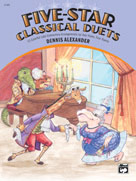
Five-Star Classical Duets and Five-Star Sacred Duets "The parts in these two books are equal in difficulty, so friends or siblings can play together. Written in the keys of C, G, and F, the arrangements include single-line melodies accompanied by single notes or blocked chords, with a few contrasting articulations and changes in hand position. The pieces most often begin with the melody in the primo and accompaniment in the secondo, with the melody switching to secondo midway through. The classical duets include such familiar classical and sacred melodies as "Ode to Joy," "The Merry Widow Waltz," and "Liebestraum," and the sacred duets feature "Amazing Grace," "Holy, Holy, Holy," and "Swing Low, Sweet Chariot." -----J.M., Clavier magazine |

Fanfare Toccata Rondo (Two piano, Four Hands) "This fast-moving, exciting composition will appeal to the teenagers in a studio. Triads move back and forth between the hands a half step apart, an abundance of 16th-note patterns repeat, scale passages move quickly, and there is some use of octaves. Both parts are written on each page, making for an easy collaboration. The piece is written in A minor and fits comfortably under the hands, which helps when the tempo is Allegro Brillante. The parts change back and forth so each pianist has a chance to play the featured part. The last page begins pp and develops to end with a smashing fff." -----D.P., Clavier magazine |
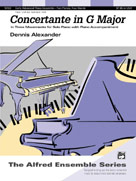
Concertante in G Major "This is a three-movement composition written in the style of a concerto, with the piano as an accompaniment. Alexander's use of scale and chordal patterns make the piece sound more difficult than it really is. The first two movements are romantic in style, while the third is much more challenging, with irregular meters and quite a few tempo changes that make this an exciting, rhythmic, 20th century-sounding movement. Only one copy is included." -------D.P., Clavier magazine |

The Magic of Music, Bk. 2 "Includes a variety of styles. Some of the titles in this creative collection are "Gypsy Fire," "Turtle Rock Rag," "High Steppers," "The Sad Troubadour," and "La Valse." Alexander has a gift for creating music that fits under student's fingers, which should ensure a good performance. These pieces also sound full." -----D.P., Clavier magazine "All the elements that motivate students and please audiences are here: lyrical melodies, flashy crossing of hands, colorful harmonies, extended pedaling, holding broken chords, ragtime rhythms, and energetic showstoppers. Sophisticated musical quality makes this suitable for older students. Nine imaginative solos, many with easy-to-memorize patterns." ------Gail Lew, The California Music Teacher magazine |

Sacred Silhouettes "Alexander has a knack for providing simple but interesting arrangements without producing an overly thick texture or awkward passages. Appropriate for students working in the second or third level of most methods, these arrangements will be a hit with players and listeners." -----J.M., Clavier magazine |
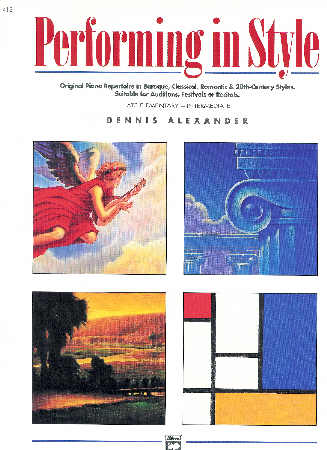
Performing in Style "The 11 original pieces in this volume are written in baroque, classical, romantic, and 20th-century styles. The five baroque pieces most effectively capture a period style; the classical, romantic, and 20th-century pieces use the appropriate stylistic gestures but occasionally evince a popular, New Age flavor. Nevertheless, the pieces and Alexander's brief synopsis for each period will provide an effective introduction to historical style. As with most of Alexander's music, students of all ages will readily respond to these enjoyable, well-crafted compositions." -----K.F., Clavier magazine |
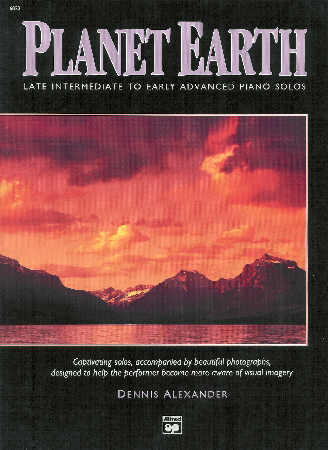
Planet Earth "In these six late-intermediate to early-advanced solos, Alexander reveals another side of his compositional style. More difficult than his earlier collections, this set aims to motivate students to play with greater expression. Vivid photos of outdoor scenes help establish a mood for each piece, but the music alone should elicit sensitive and even impassioned playing. I especially recommend "Spring Waters," "Jester," "Mountain Nocturne," and "Turbulence!" -----J.M., Clavier magazine |
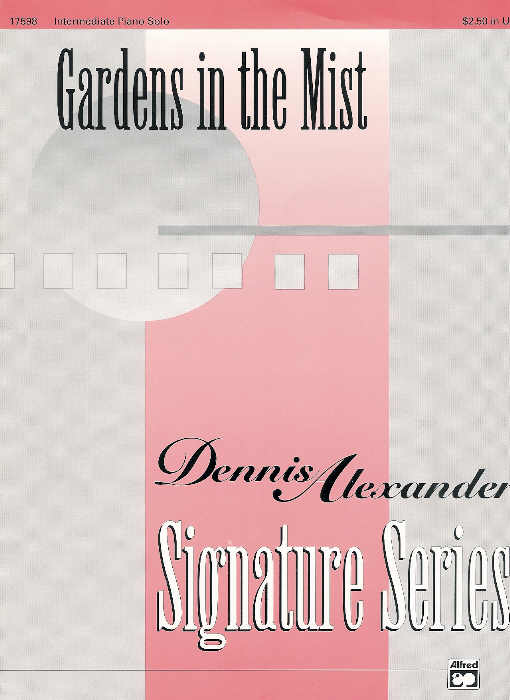
Gardens in the Mist "Alexander has a misty sound produced by the combination of quartal harmony and whole-tone scales. Although the key signature indicates C major, and the piece often does sound like it is in C, the seven-note, whole-tone runs start on F and therefore include C# and D#. The rhythm appears complicated on the page, but the feel of the piece makes it easy to play and count once the student masters the basic patterns in the first and third measures. This piece is perfect for a dreary, foggy day." -----C.T., Clavier magazine |

Animal Magic "This creative music opens the world of animals to young students. The pieces explore the sights, sounds, and characters of several animals through imaginative settings written in five-finger positions. The titles and illustrations include "Cantankerous Kangaroo," "Gnu Sounds," "Hairy Canary Named Fred," "No Non-Scents!," "There's a Hippo in My Tree," and "Slippery, Slimery, Slithery Snake." The music is sure to delight." ----- J.M., Clavier magazine |
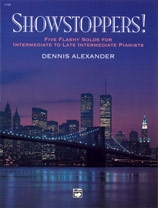
Showstoppers "Written with patterns that fit the hand, these five flashy solos provide quick gratification for intermediate students. They are inviting and provide a pickup. Titles include "El Diablo," "Frenzy," "Perpetual Motion," "Tempest," and "Terra-Toccata." -----J.M., Clavier |
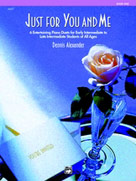
Just for You and Me, Bks. 1 & 2 "The selections in these volumes are attractive to the ear and easy to play. The popular style is pleasing; students will readily respond to the tender ballads, waltzes, rags, and Latin-tinged pieces. Generally, the primo parts contain melodic lines while the secondo parts provide harmonic and rhythmic support. Each volume contains six selections." -----K.F., Clavier magazine |
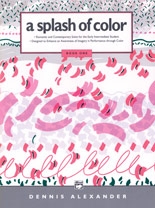
A Splash of Color, Bks. 1 & 2 "Alexander's two progressive volumes of early- and mid-intermediate solos can stimulate students to associate color and music, just as Robert Starer did at a more advanced level in his Sketches in Color. These pieces aim to awaken the imagination and elicit a musical response from students; titles include "Blue Boogie," "Forest Green," "A Touch of Gold," "Violetta," and "Zinc Pink." I strongly recommend these collections." -----J.M., Clavier magazine |
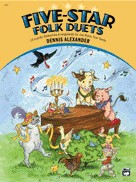
Five-Star Folk Duets "Most children will recognize the folk songs in this collection. The arrangements have both parts, which are of equal difficulty, sharing some of the melody. The primo and secondo are written within and staff of the bass and treble clefs with directions to go up or down an octave. The 13 duets include practical fingering." -----D.P., Clavier magazine |
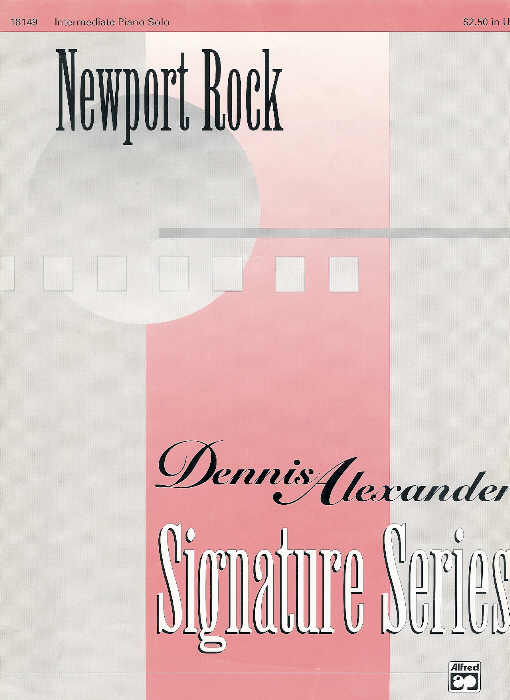
Newport Rock "Alexander has written another winner, an ABA rock piece with a robust sound and energetic rhythms. The B section makes use of augmented chords for an interesting harmonic contrast." ----- S.H., Clavier magazine |
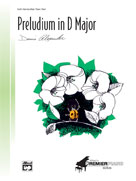
Preludium in D Major "The singing melody found in both parts and the easy, rocking feel of this tranquil six-page duet will captivate students. The piece calls for an expressive interpretation and a seamless legato melody; the writing is pianistic. Give this to students who enjoy playing lyrical, tender music." ----- J.M., Clavier magazine |
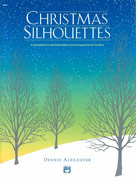
Christmas Silhouettes- The mix of contemporary sounds with traditional harmonies in this collection will appeal to teenage students, especially those who enjoy playing expressive literature. Alexander's arrangements are well written for the instrument; titles include "The First Noel," "O Come, O Come, Emmanuel," "Silent Night," "Still, Still, Still," and "Up on the Housetop". ----K.F. Clavier magazine |
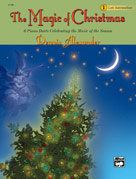
The Magic of Christmas, Bk. 3 - Six Piano Duets Celebrating the Music of the Season arranged by Dennis Alexander. These artistic and beautifully arranged duets have equally interesting secondo and primo parts because each includes melodic, harmonic, and rhythmic motives. Most of the pieces have lovely, flowing sounds from broken chords, arpeggios, and scale passages. "We Three Kings" is the only jazzy arrangement of the set, with blues harmonies, syncopated eighths, triplets, and grace-notes. The editorial fingering, pedaling, and expression marks are excellent; included are some of the most-loved traditional carols, such as "Carol of the Bells," "The Coventry Carol," and "Gesu Bambino." ---- L.Z. Clavier magazine |
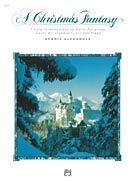
A Christmas Fantasy - Many teachers and students eagerly anticipate new collections of arrangements or compositions by Dennis Alexander. This book of seven late-intermediate to early-advanced carol arrangements will not disappoint his fans or newcomers to the Montana compoer's work. The satisfying solos vary in mood and style from the lyrical and tender to the jazzy and bravura, imbuing "Silent Night," "Hark! The Herald Angels Sing," "God Rest Ye Merry, Gentlemen," and other familiar carols with new energy. ---- K.F. Clavier magazine |
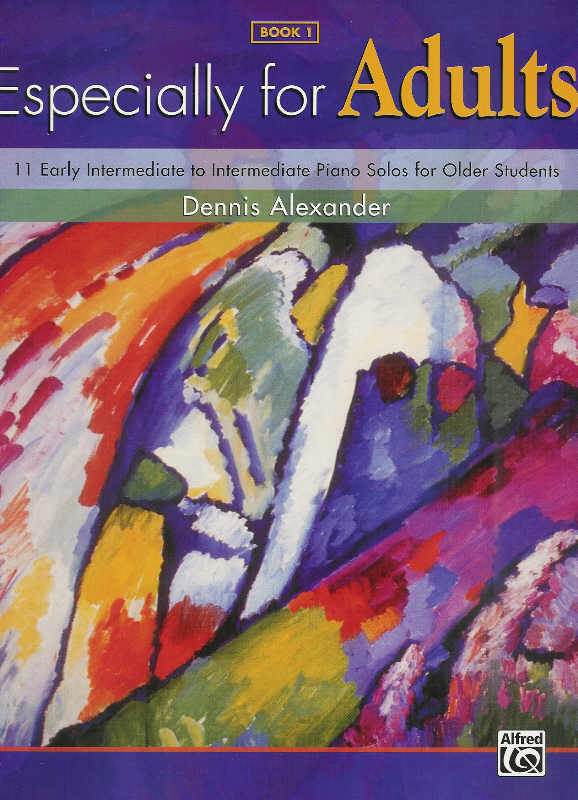
Especially for Adults, Bk. 1 3 Reviews Review #1: This collection contains eleven early intermediate solos written and arranged by Mr. Alexander. The arrangements are the theme from Liszt’s "Hungarian Rhapsody No. 2", Borodin's "Polovetsian Dance" and "Plaisir d'amour" by Martini. Of the original solos, I found "Reflections" to be very satisfying, with the flowing style I so admire in Alexander's works. Written in the accessible key of G in ABA form, the B section feels "comfortable" with a good pattern for wrist rotation. The other piece I especially liked was "Day’s End", another lyrical work. As in most Alexander collections, he includes some "pop" sounds, such as "On Ol' Broadway!" and "Sneaky Kinda Rag." This collection is a welcome addition to the Dennis Alexander Library. --Piano Guild Notes - Winter 2008 - Dr. Vicki King, reviewer Review #2: Books 1 & 2 - With everything from Classical favorites to flamenco, ragtime, and boogie-woogie, there is something in these books to suit every taste. The editioin includes tasteful arrangements of well-known works, such as the theme from the second movement of Beethoven's "Sonata Pathétique" and "Danny Boy." Original compositions by Alexander are especially nice, with pleasant harmonies in the form of arpeggios and chords. Each piece focuses on an aspect of technique by repeating short passages, literally or in sequences, without sacrificing musical interest. -- Clavier magazine, Nov. 2007 - J.S.S., reviewer Review #3: Each of these books feature 11 pieces in contrasting style that offer a variety of enjoyable supplementary music. Book 1 includes original Broadway, Latin, ragtime, romantic and blues pieces, as well as three simplified classical arrangements. Each piece is enjoyable to play and offers musical motivatioin within the "early intermediate" level. - American Music Teacher - October-November 2007 -- Debra Perez, reviewer |
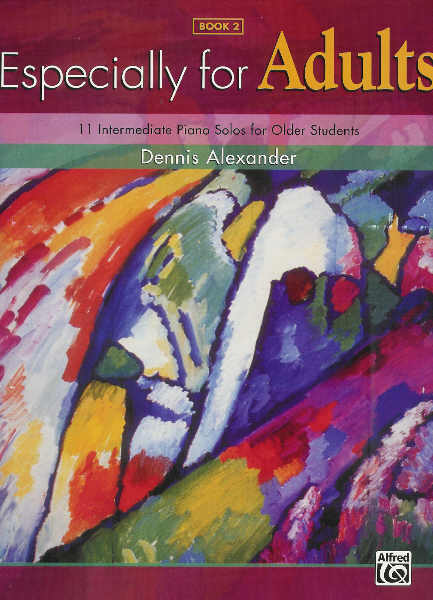
Especially for Adults, Bk. 2 - The solos in the "Especially for Adults" series have been written to give the adult student a variety of stylistic pieces, both originally composed and arranged familiar melodies. Book 2 is appropriate for the Intermediate level student. It contains "Danny Boy", "Simple Gifts" and the theme from the second movement of Beethoven's "Sonata Pathetique". The latter has been arranged in the key of C and uses an Alberti bass accompaniment. These solos have specific fingerings and pedaling to help the adult student be successful quickly. In "Starbeams" and "Thinking of You", Alexander has written lovely, lyrical pieces in Romantic style. "Lots o' Blues" and "Midnight Rag" are wonderful pieces in a contemporary jazz style. "Song Without Words" contains several expressive markings to guide the student. Book 3 begins with "Cappuccino Rag", a fun piece with a simple L.H. and traditional syncopated R.H. "Just Groovin" offers the student another opportunity for jazzy, rhythmical playing. Alexander's arrangement of Chopin's "Nocturne in E flat Major" keeps the original key and rich harmonies. Adults will also recognize and enjoy the arranged version of "Canon in D/New World Symphony Medley". These arrangements sound so much like the original, the adult student will be instantly gratified by their playing. It was a pleasure to play through these two collections. Any teacher or student who has been charmed in the past by Dennis Alexander's compositions will not be disappointed. --- Piano Guild Notes - Winter 2008 - Dr. Sandra Stewart, reviewer
|
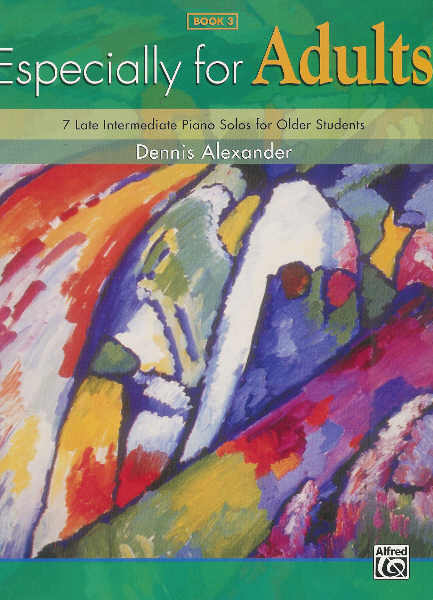
Especially for Adults, Bk. 3 - The solos in the "Especially for Adults" series have been written to give the adult student a variety of stylistic pieces, both originally composed and arranged familiar melodies. Book 2 is appropriate for the Intermediate level student. It contains "Danny Boy", "Simple Gifts" and the theme from the second movement of Beethoven's "Sonata Pathetique". The latter has been arranged in the key of C and uses an Alberti bass accompaniment. These solos have specific fingerings and pedaling to help the adult student be successful quickly. In "Starbeams" and "Thinking of You", Alexander has written lovely, lyrical pieces in Romantic style. "Lots o' Blues" and "Midnight Rag" are wonderful pieces in a contemporary jazz style. "Song Without Words" contains several expressive markings to guide the student. Book 3 begins with "Cappuccino Rag", a fun piece with a simple L.H. and traditional syncopated R.H. "Just Groovin" offers the student another opportunity for jazzy, rhythmical playing. Alexander's arrangement of Chopin's "Nocturne in E flat Major" keeps the original key and rich harmonies. Adults will also recognize and enjoy the arranged version of "Canon in D/New World Symphony Medley". These arrangements sound so much like the original, the adult student will be instantly gratified by their playing. It was a pleasure to play through these two collections. Any teacher or student who has been charmed in the past by Dennis Alexander's compositions will not be disappointed. --- Piano Guild Notes - Winter 2008 - Dr. Sandra Stewart, reviewer |
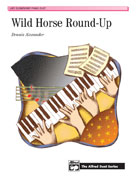
Wild Horse Round-Up - One Piano, 4 Hands --- A series of galloping fourths in the secondo opens this lively duet. The bass part continues the staccato fourths in the right hand with single notes or blocked fifths in the left, providing an energetic rhythmic accompaniment. An ascending pattern in the primo increases the drama, along with a greater variety of hand-position shifts. As the secondo briefly takes the melody, the primo plays hand-over-hand crossovers and slurred figures. This is a show stopper for any recital ----Clavier magazine, S.O reviewer |
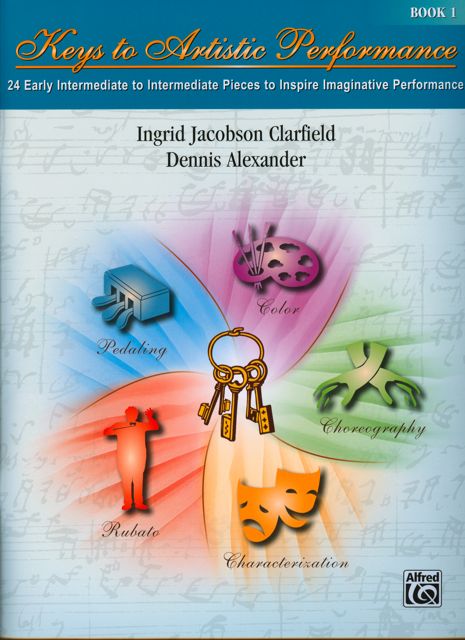
Keys to Artistic Performance, Bk. 1 Every teacher seeks music books that will help his or her students develop (and improve!) their music and artistic performances. With their repertoire of various pieces from five stylistic periods, these two volumes address techniques ranging from pedaling, rhythmic flexibility, and rubato to voicing, expressivity, and choreography. These skills and tools promise to transform a student's average performance to one of art and perfection. In addition, the presence of numerous notations throughout the sheet music helps students with articulation, creation of beautiful tone, interpretation, tone quality, and keyboard choreography. Included are new pieces composed by Dennis Alexander, standard repertory by master composers, and lesser-known gems by composers such as Amy Beach, Cecile Chaminade, Alfredo Casella, Vladimir Rebikov, Federico Mompou, Mikhail Glinka, and many more. -Gail Lew, Director of Piano Publications, Sheet Music Plus.com. Member MTNA, CAPMT, MTAC, National Guild of Piano Teachers |

Keys to Artistic Performance, Bks. 1 & 2 Ingrid Jacobson Clarfield and Dennis Alexander (Bk. 1 - Early Intermediate to Intermediate; Bk. 2 - Intermediate to Late Intermediate) The introductory material includes a description and graphic representation for each of the "keys" with suggested techniques and examples for practice to help achieve the artistic result. The vocabulary list for the characterization key is extensive with expressive words to help build musical interpretations. Especially significant is the discussion of choreography to inform how the movement of the performer affects the experience for the audience. In addition, the use of choreography symbols to help students interpret specific movements to model is a beneficial and effective approach. The 24 compositions in book 1 and 23 compositions in book 2 cover a range of intermediate performance repertoire from the romantic and contemporary composers, including Schubert, Schumann, Chaminade, Streabbog, Bartok and Beach. There are also several original compositions by Dennis Alexander in both books. The authors identify the specific "keys" that should be featured in each composition and include suggestions for achieving the desired effect. This two-volume set is an excellent addition to performance literature and one that will be instructive for botyh students and teachers in developing artistic and musical performances. ---- Reviewed by Carolyn F. Walden, Birmingham, AL American Music Teacher magazine |

Busybody - Busybody, by Dennis Alexander, is a lively piece that is easy to play because it includes five-finger and easy scale construction. The opening presents an interesting mixture of harmonies in both flat and sharp keys. With note values predominantly in quarter- and eighth-note patterns, this fun piece makes use of a large range of the keyboard and settles in A as its main key. Staccatos and two-note slurs add to the lively character of the music; listeners can almost hear the stories that pass from one busybody to the next. This sheet music offers variety to a regular diet of musical study and would be an excellent recital project. Susan Osborn, Clavier. (September/October 2008). |
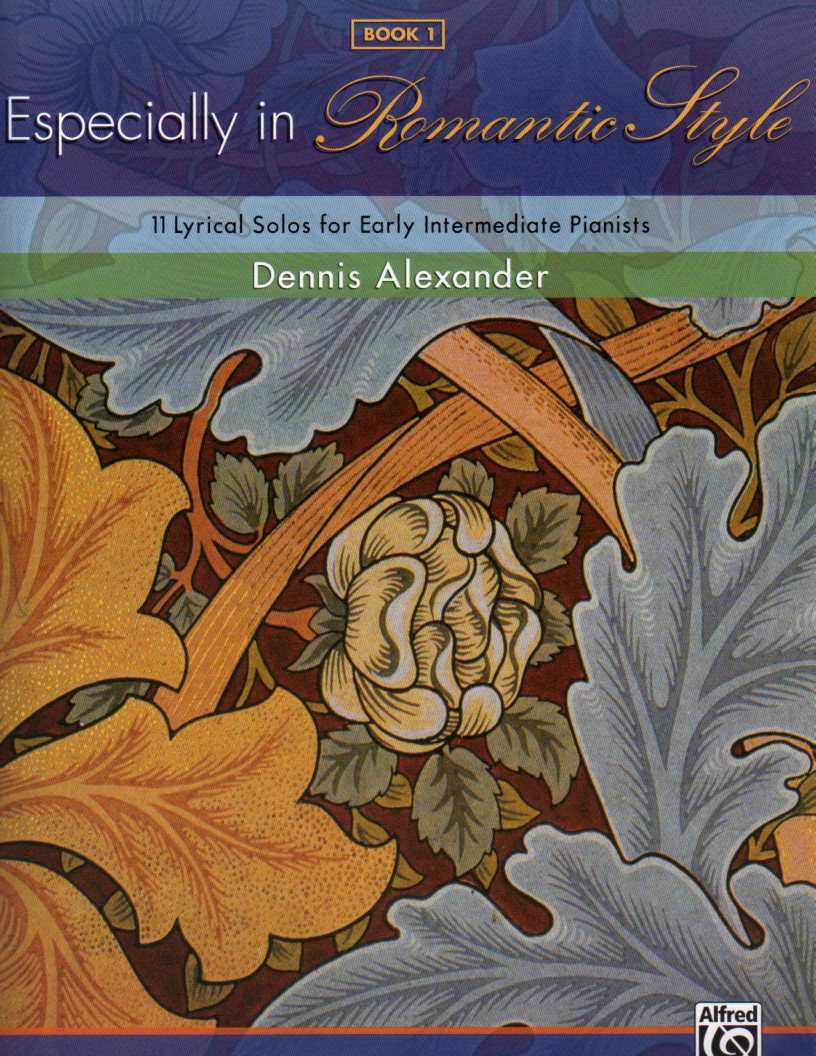
Especially in Romantic Style -- Dennis Alexander's three volumes, "Especially in Romantic Style", published by Alfred, provide opportunities for the intermediate pianist to explore a wide range of appealingly songful, harmonically rich, evocative and descriptive pieces. The pieces invite and inspire expressive playing. The pianist will want to experiment with mood, character and imagery, through tone, color, pedaling, shaping, rubato and, above all, listening. The 11 pieces in Book 1 are intended for the early intermediate pianist. Ten are two pages long, the last contains three pages, and, as is true in all three volumes, there is a gradual increase in technical demands from first piece to last. Titles such as "Summer Dreams" and "Footprints in the Sand" describe pieces in a variety of moods, meters, and tempi, unified, for the most part, by their ternary forms, three voice textures and lyrical qualities. The expressive "Lost Romance Blues" uses the 12-bar blues pattern. Book 2, for intermediate pianists, contains eight pieces, almost all three pages long and characterized by greater use of dotted rhythms and syncopation, wider ranging melodic and accompaniment patterns, longer ternary forms with more florid melodic variations, and unexpected modulations. Two pieces, 'Boston Blues" and "Jazz Romance" are explicitly jazz influenced. Book 3, with its still more expansive seven solos, is intended for the late intermediate pianist. These colorful pieces are more chromatic, have fuller textures and more complex rhythmic demands. There are greater technical challenges here too, including wide ranging accompaniment patterns requiring multiple crossings, much expansion and contraction within the hand to accomodate voicings and more subtle use of pedal. The composer's editing underscores his own superb background as a pianist and teacher. I found just enough fingerings, dynamic markings, tempi and pedal indications to help student and teacher, while allowing individual interpretive decisions important for polishing and projecting the music. --------Reviewed by Phyllis Alpert Lehrer, NCTM, Westminster Choir College of Rider University. AMT Magazine, Oct./Nov. 2009 |
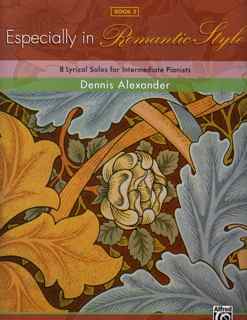
Especially in Romantic Style -- Dennis Alexander's three volumes, "Especially in Romantic Style", published by Alfred, provide opportunities for the intermediate pianist to explore a wide range of appealingly songful, harmonically rich, evocative and descriptive pieces. The pieces invite and inspire expressive playing. The pianist will want to experiment with mood, character and imagery, through tone, color, pedaling, shaping, rubato and, above all, listening. The 11 pieces in Book 1 are intended for the early intermediate pianist. Ten are two pages long, the last contains three pages, and, as is true in all three volumes, there is a gradual increase in technical demands from first piece to last. Titles such as "Summer Dreams" and "Footprints in the Sand" describe pieces in a variety of moods, meters, and tempi, unified, for the most part, by their ternary forms, three voice textures and lyrical qualities. The expressive "Lost Romance Blues" uses the 12-bar blues pattern. Book 2, for intermediate pianists, contains eight pieces, almost all three pages long and characterized by greater use of dotted rhythms and syncopation, wider ranging melodic and accompaniment patterns, longer ternary forms with more florid melodic variations, and unexpected modulations. Two pieces, 'Boston Blues" and "Jazz Romance" are explicitly jazz influenced. Book 3, with its still more expansive seven solos, is intended for the late intermediate pianist. These colorful pieces are more chromatic, have fuller textures and more complex rhythmic demands. There are greater technical challenges here too, including wide ranging accompaniment patterns requiring multiple crossings, much expansion and contraction within the hand to accomodate voicings and more subtle use of pedal. The composer's editing underscores his own superb background as a pianist and teacher. I found just enough fingerings, dynamic markings, tempi and pedal indications to help student and teacher, while allowing individual interpretive decisions important for polishing and projecting the music. --------Reviewed by Phyllis Alpert Lehrer, NCTM, Westminster Choir College of Rider University. AMT Magazine, Oct./Nov. 2009 |
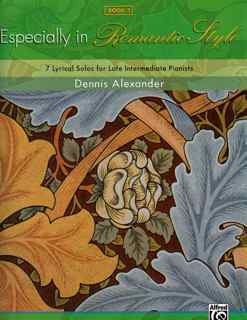
Especially in Romantic Style -- Dennis Alexander's three volumes, "Especially in Romantic Style", published by Alfred, provide opportunities for the intermediate pianist to explore a wide range of appealingly songful, harmonically rich, evocative and descriptive pieces. The pieces invite and inspire expressive playing. The pianist will want to experiment with mood, character and imagery, through tone, color, pedaling, shaping, rubato and, above all, listening. The 11 pieces in Book 1 are intended for the early intermediate pianist. Ten are two pages long, the last contains three pages, and, as is true in all three volumes, there is a gradual increase in technical demands from first piece to last. Titles such as "Summer Dreams" and "Footprints in the Sand" describe pieces in a variety of moods, meters, and tempi, unified, for the most part, by their ternary forms, three voice textures and lyrical qualities. The expressive "Lost Romance Blues" uses the 12-bar blues pattern. Book 2, for intermediate pianists, contains eight pieces, almost all three pages long and characterized by greater use of dotted rhythms and syncopation, wider ranging melodic and accompaniment patterns, longer ternary forms with more florid melodic variations, and unexpected modulations. Two pieces, 'Boston Blues" and "Jazz Romance" are explicitly jazz influenced. Book 3, with its still more expansive seven solos, is intended for the late intermediate pianist. These colorful pieces are more chromatic, have fuller textures and more complex rhythmic demands. There are greater technical challenges here too, including wide ranging accompaniment patterns requiring multiple crossings, much expansion and contraction within the hand to accomodate voicings and more subtle use of pedal. The composer's editing underscores his own superb background as a pianist and teacher. I found just enough fingerings, dynamic markings, tempi and pedal indications to help student and teacher, while allowing individual interpretive decisions important for polishing and projecting the music. --------Reviewed by Phyllis Alpert Lehrer, NCTM, Westminster Choir College of Rider University. AMT Magazine, Oct./Nov. 2009 |
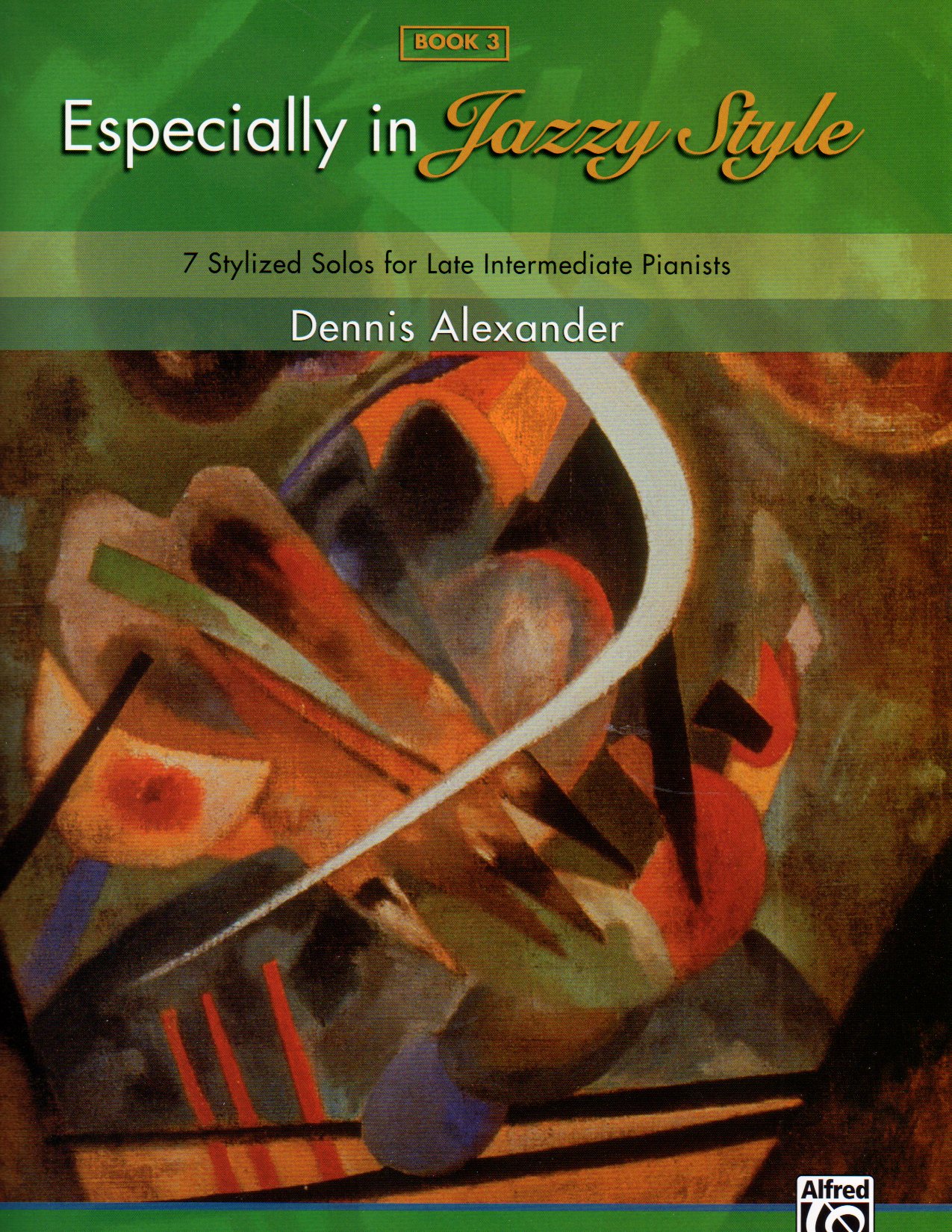
Especially in Jazzy Style These jazz-style selections, arranged in three volumes, are intended for intermediate pianists graded from early to late levels of difficulty. Each volume contains selections in the jazz waltz, swing, Latin and ballad styles. Much of the melodic content uses the blues scale as its basis, giving many selections a warm blues flavor. Since the author is an experienced jazz pianist, it is no surprise each selection is written with a thorough knowledge of jazz/pop harmony and chord voicing. His selection of styles and quality of output is quite consistent, although one can single out some highlights such as "Rhythmicon" in Volume I, "Cool Dude" in Volume II, and "In My Own Space" in Volume III. Selections, ranging from two pages to four, are well put together and demonstrate a good knowledge of structure. Perhaps a few could have more creative endings and/or introductions. Volume I allows pianists' hands to stay mostly in the same range, syncopation is somewhat minimal, and chords are basic---never having more than three notes in one hand. The left hand does not have to extend its position beyond an octave in accompaniment figures. Volume II moves the left hand from the lower to the mid-range of the keyboard and extends its position to a tenth in accompaniment figures. Harmonies use seventh chords including the major seventh chord. Some more unusual time signatures appear such as 6/8 in "Jazz Nocturne in Bb Major" and mixed meters of 3/4, 4/4, and 5/4 in "With Mixed Emotions. Volume III is the most advanced featuring complete harmonies, chords with four notes in one hand, and lots of syncopation. Advanced pianists would find these selections to be challenging sight reading. The left hand sometimes has to move quickly from the low register to the mid register (most apparent in "A Million Miles Away"). The closing selection, "Jazz at Five," is a challenging mixed meter composition using 3/4, 4/4, 5/4, and 6/4 time signatures. As a contribution to the intermediate repertoire of jazz piano compositions, Alexander has succeeded in giving us challenging and interesting selections both jazz and classical pianists will enjoy. These pieces also function as good precursors to the world of improvisation. -----Reviewed by Geoffrey Haydon, Georgia State University. American Music Teacher, December/January 2010-2011 |
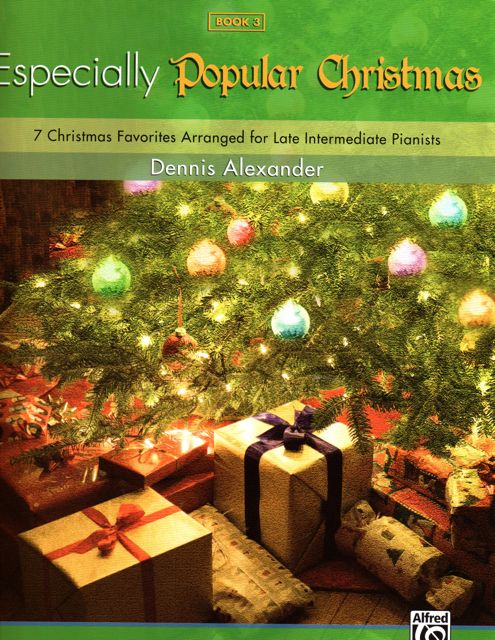
Especially Popular Christmas, Bks. 1, 2 & 3 When he was a boy, Dennis Alexander listened to Christmas music on his parent's large Curtis Mathes console record player. At the time, he decided that Elvis Presley's "Blue Christmas" was "almost the 'coolest' thing" he had ever heard, and these three volumes of Christmas arrangements reflect the composer's love for timeless popular holiday songs. Each book contains seven or eight pieces, for a total of twenty-three arrangements in the series, most of them secular holiday favorites. The books contain plenty of "Alexander-esque" modulations, suspensions, sophisticated rhythms, and appealing harmonies. Book 1 (early intermediate-to-intermediate level) contains a mix of upbeat and reflective, lyrical selections. A jazzy "(There's No Place Like) Home for the Holidays" pairs with a contemplative "The Holly and the Ivy" that is set with gentle hemiolas and syncopations. Book 2 (intermediate) includes "Blue Christmas," the nostalgic jazz ballad "Have Yourself a Merry Little Christmas," and a boogie-woogie version of "Santa Claus is Comin' to Town." The pieces in Book 3 (late intermediate) are especially mature sounding, and students will be attracted to fresh arrangements of "Believe" from the movie The Polar Express and "The Gift" by Jim Brickman. These pieces have a good deal of pedagogical merit. They offer rhythmic challenges, extended legato patterns in both hands, a variety of articulations, and ample opportunity to teach expressive phrasing and legato pedaling. Another strength of this series is the number of songs which are probably not well known to some of the younger generation: arrangements of "The Christmas Waltz," "There is No Christmas Like a Home Christmas," and "Mistletoe and Holly" will introduce students to classic hits and add spice to holiday recitals.-----Reviewed by Vanessa Cornett-Murtada; Clavier Companion, September/October 2011. |
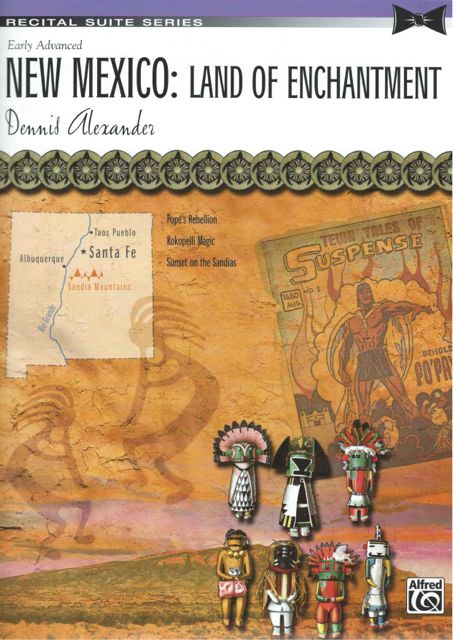
New Mexico: Land of Enchantment (Recital Suite) "New Mexico: Land of Enchantment", composed by veteran pedagogue Dennis Alexander, includes three pieces for early-advanced students. "Popé's Rebellion," first in the set, is a fast-paced thriller suitable for competitions and recitals. The second, "Kokopelli Magic," is snappy and rhythmic, whereas the final piece, "Sunset on the Sandias," is placid and adoringly beautiful. Reviewed by Steven Brundage, Bob Jones Academy, American Music Teacher Magazine, June/July 2013 |
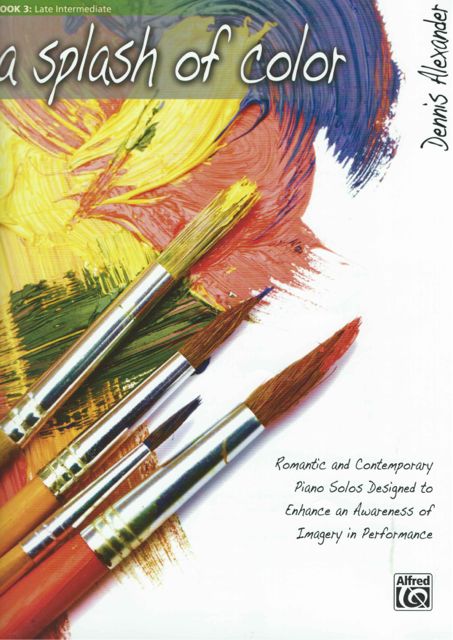
A Splash of Color, Bk. 3 "My students have enjoyed the levels one and two of this series, so I am sure this one will be of great benefit as a supplementary book. In this collection of seven Romantic and Contemporary solos for the late intermediate-level student, Alexander uses imagery to entice the students by "stretching their imaginations to new heights." The titles include Lemon Zest, Fields of Lavender and Tango a la Mango. The pieces offer a variety of pedagogical concepts. Titanium Toccata is a particularly "wild and crazy" piece moving the full range of the keyboard, mixing harmonic chord sounds within the key of e minor. It contains rhythmic complexity in the middle section. My high school freshman boy is performing this piece and loves it. Dr. Sandra Stewart, reviewer, National Guild Notes, Summer 2014 |
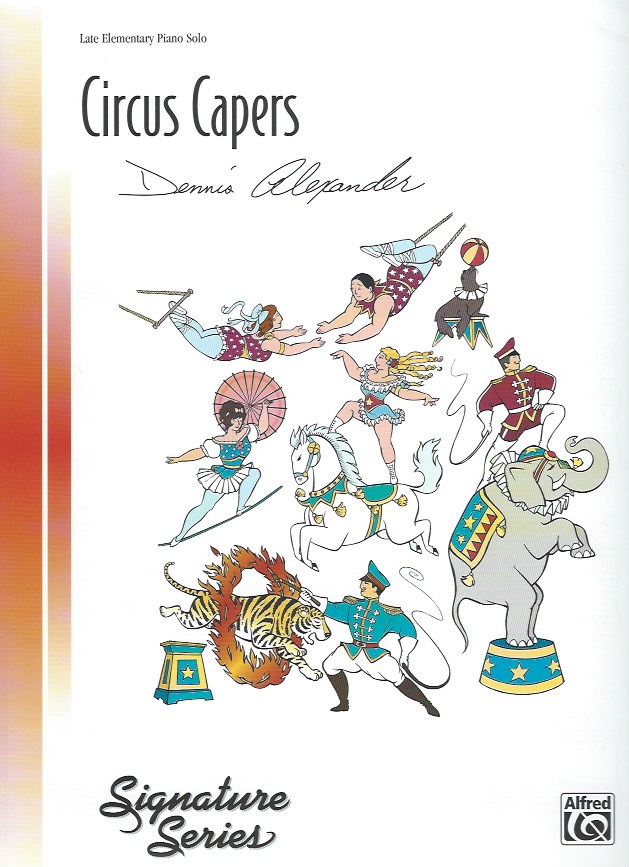
Circus Capers - This late elementary piece is another Alexander gem. He uses many staccatos and various hand crossings to achieve the sound of clowns doing what they do best-------make people laugh. This is a piece to make a student and teacher smile, with it's cute minor seconds. Written in the key of G, the melody alternates between the hands. In the middle section, the student plays in a good, comfortable 5-finger pattern and remains in this G position, except with octave changes, until the end. This is a delightful piece, sure to please the audience. --- Dr. Vicki King, reviewer; Piano Guild Notes, Fall 2014 |
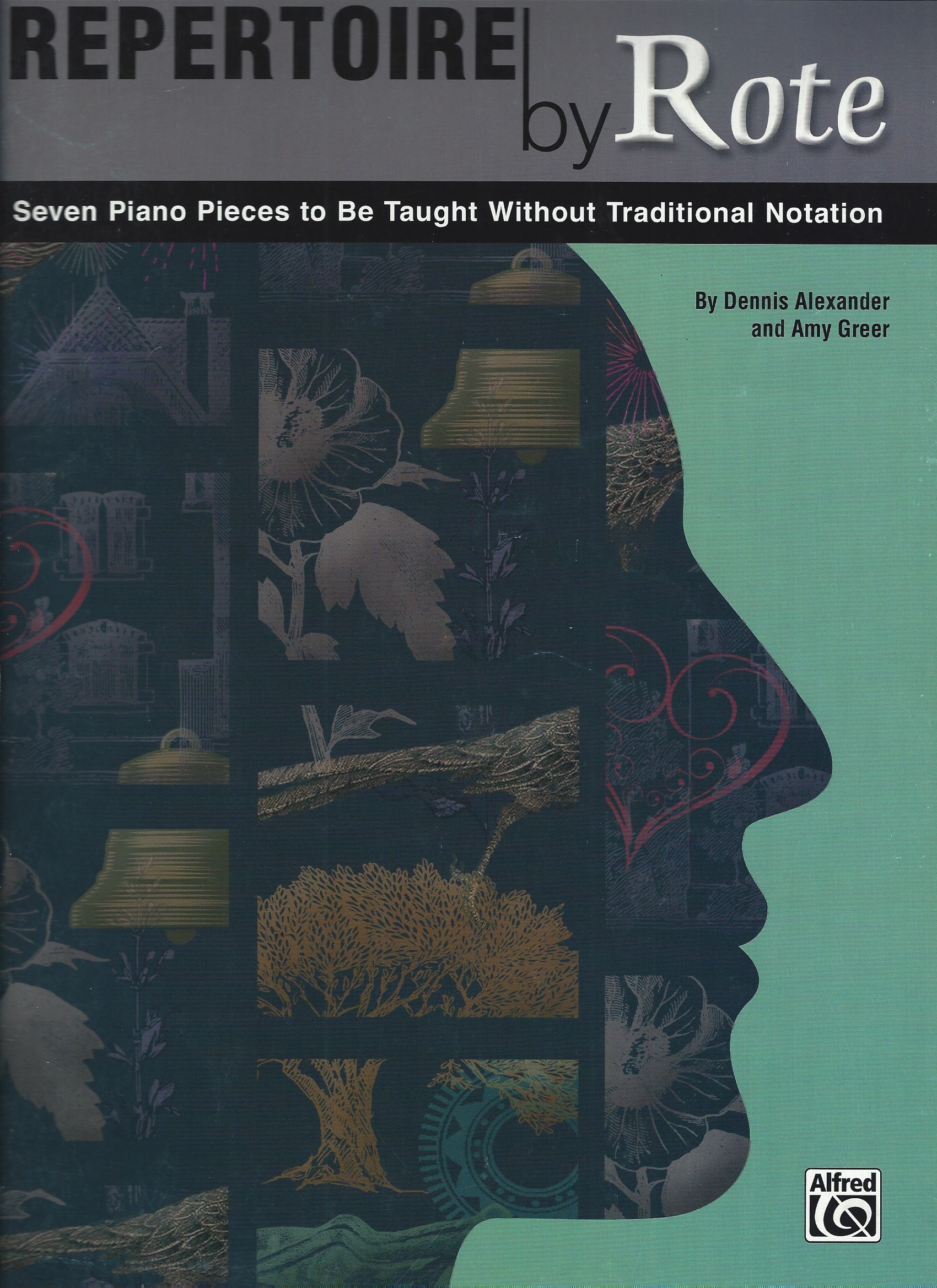
Repertoire by Rote -- Amy Greer writes a wonderful essay in the preface to this collection about her experience with teaching beginners their first pieces by rote. One of the pieces she taught to a six-year old boy and then to a sixty-six-year-old woman, each with only a month of piano lessons behind them. "They were both grinning from ear to ear the entire time." These 7 pieces can be used with beginners of all ages so that they have something satisfying to play from the very beginning of their study. Before each piece, teacher ideas are given for breaking the music into small segments to help the students learn. The teacher reads the actual music, and the student page has a keyboard showing where the fingers are placed, with graphics showing finger numbers written separately or simultaneously as a block. Duet parts are written for the teacher on several of the pieces to make the student's part even more aesthetically pleasing. Small children will especially love "Green Frogs," played all over the piano, with the bullfrogs played on the two lowest black keys. All of the pieces have words. In "Bells Are Ringing", the words describe what is being played, such as "G and A and third". This is a good collection for teachers to use to supplement any method as a resource. Teachers are encouraged to buy this book for their studios. Alfred gives the purchaser of the book the permission to photocopy the student maps as needed.-----Dr. Vicki King, Piano Guild Notes, Spring 2018 |
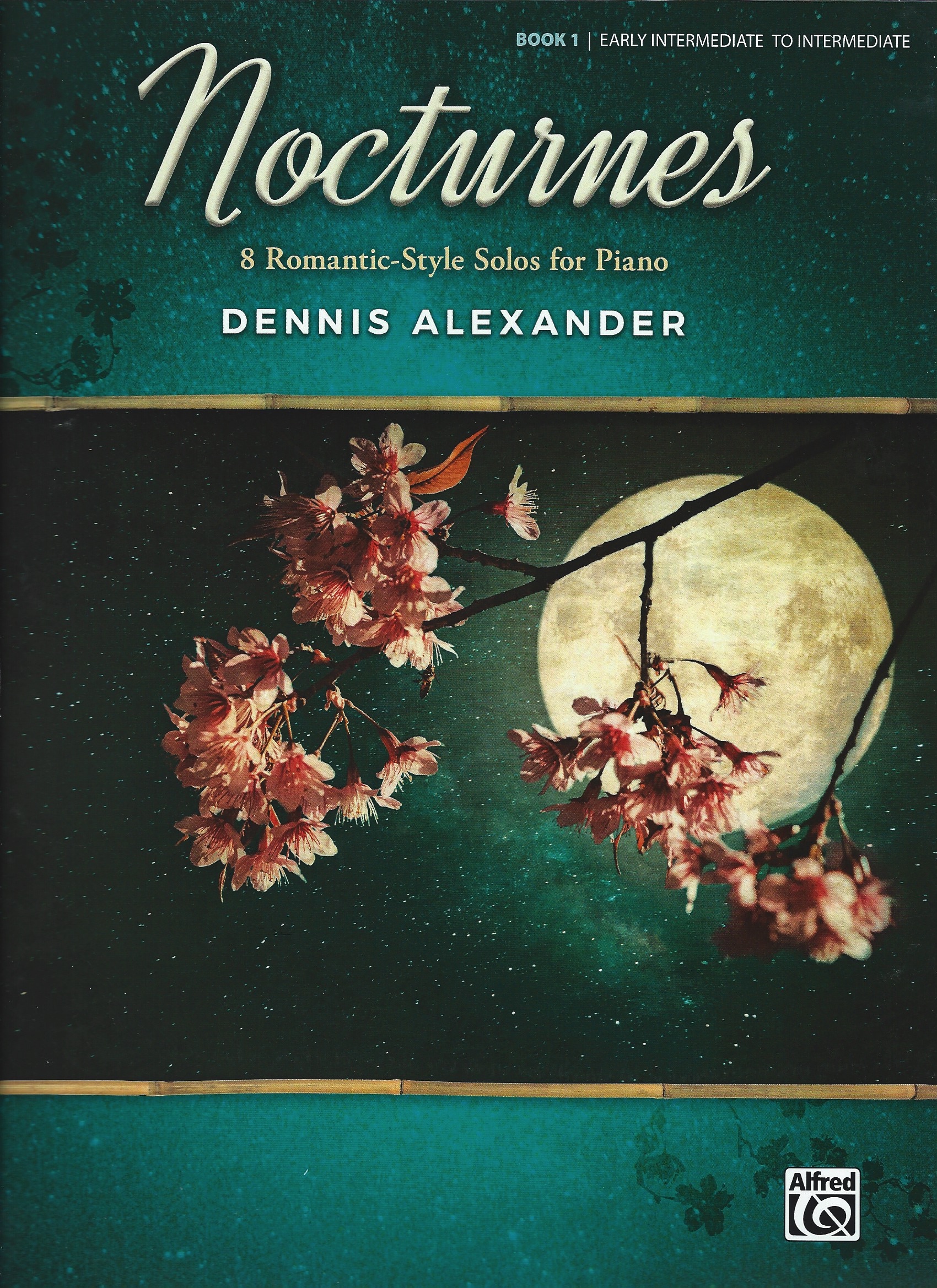
Nocturnes: 8 Romantic-Style Solos for Piano, Book 1 - Alfred Music, 2018. 24 pp., $8.99. Early-intermediate to intermediate. Composer Dennis Alexander has once again created an inspiring collection of compositions that fulfills a need for the intermediate pianist. Influenced by Chopin, Alexander composed 14 nocturnes written within two books. Alexander stated, "I have always longed for original nocturnes similar in style and form to the Chopin nocturnes, but easier in technical difficulty." Alexander achieved his goal tenfold, and Chopin-like nocturnes are now accessible to the intermediate student. Editor markings are clear and the paper is of high quality. The layout is well-conceived with no awkward page turns. Footnotes detailing how to play the ornaments are a nice pedagogical addition. Suitable for children and adults, Alexander's recital-worthy nocturnes make a fine introductioni to the nocturnes of Field and Chopin. Recordings performed by Alexander are available on his personal website. No. 1. Simple melody in right hand. Ad lib section. Interesting pedal effects create mystical atmosphere. No. 2. Melancholy mood, interesting melodic left hand. No. 3. Hand-over-hand sections are fun! Good work to study pedal technique. No. 4. Charming left-hand melody in the mid-section. Effective coda. No. 5. Many accidentals. 9/8 time signature. Dramatic appassionato section No. 6. Beautiful melodic lines. Great piece to study phrase shape and evenness. No. 7. Haunting melody with contrasting mid-section. No. 8. Ideal piece to reinforce active listening (decay and layering techniques). Reviewed by William Whipple, NCTM, University of Wisconsin-Eau Claire. AMT Magazine: October/November 2018 For video recordings and peddagogical tips, see: www.Alfred.com/AlexanderNocturnes |
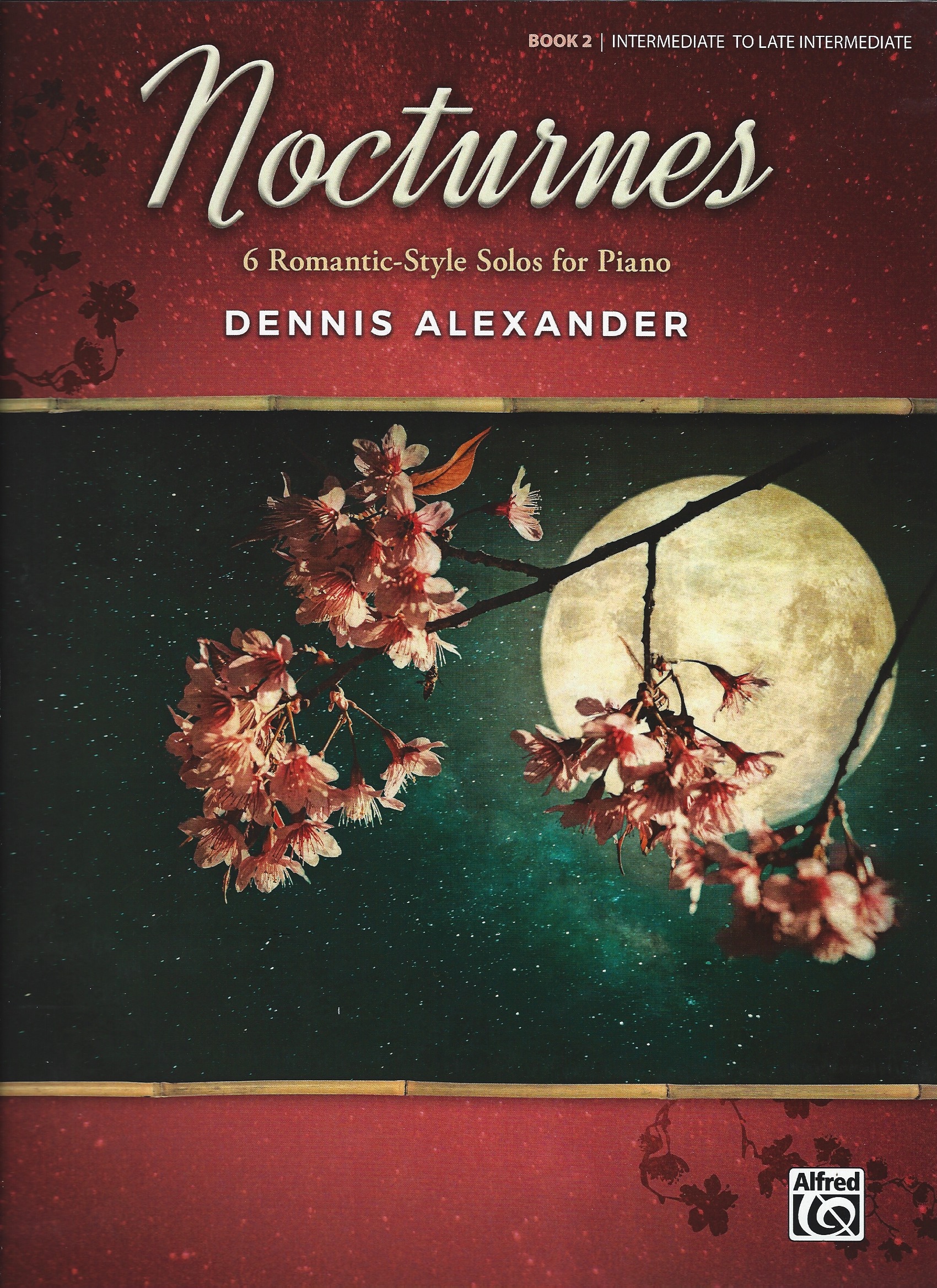
Nocturnes: 6 Romantic-Style Solos for Piano, Book 2 - Alfred Music, 2018. 24 pp., $8.99. Intermediate to Late Intermediate Composer Dennis Alexander has once again created an inspiring collection of compositions that fulfills a need for the intermediate pianist. Influenced by Chopin, Alexander composed 14 nocturnes written within two books. Alexander stated, "I have always longed for original nocturnes similar in style and form to the Chopin nocturnes, but easier in technical difficulty." Alexander achieved his goal tenfold, and Chopin-like nocturnes are now accessible to the intermediate student. Editor markings are clear and the paper is of high quality. The layout is well-conceived with no awkward page turns. Footnotes detailing how to play the ornaments are a nice pedagogical addition. Suitable for children and adults, Alexander's recital-worthy nocturnes make a fine introductioni to the nocturnes of Field and Chopin. Recordings performed by Alexander are available on his personal website. No. 9. Frequent two against three writing. Extended left-hand, sixteenth-note passages. No. 10. Extended trills, Soaring and expansive right-hand passages. No. 11. More difficult than previous pieces. 5/8 time signature. Left-hand, sixteenth-note runs with a more involved right hand. Much chromaticism. No. 12. Finger substitutions. Glorious chordal section requires proper voicing. No. 13. Left-hand, sixteenth-note passages with right-hand chords. Occasional two against three writing. No. 14. Perhaps the most demanding (facility and technical). A few passages in thirds. Reviewed by William Whipple, NCTM, University of Wisconsin-Eau Claire. AMT Magazine: October/November 2018 For video recordings and peddagogical tips, see: www.Alfred.com/AlexanderNocturnes |

Nocturnes: 8 Romantic-Style Solos for Piano, Book 1, Early Intermediate to Intermediate; 6 Romantic-Style Solos for Piano, Book 2, Intermediate to Late Intermediate, by Dennis Alexander. Dennis Alexander has contributed 14 new gems for the pedagogical piano repertoire in this new publication of nocturnes. They are written similar in style and form to the nocturnes of Chopin but are much easier and more accessible to students. As in many of Alexander's works, they feature an original melody over a flowing left-hand accompaniment. He writes many marks of expression, but students and teachers are encouraged to interpret these pieces with a lovely Romantic-style stretch at the end of sections---never metronomic, but always expressing the beauty of the music. He includes so many helpful fingerings and the pieces all feel good under the hands, as in all Alexander pieces. He writes very careful pedaling to enhance the beauty and color. In Book 1, the Nocturne No. 1 in C Major is very accessible, using varied registers of the piano. He includes a small ad lib cadenza-like section before the return of the melodic material. He says to play the ending with a small ritard. No. 6 in A minor is perhaps the next easiest of the Book 1 set. The melody is found in the right hand, but the left-hand accompaniments almost all start the measures with a rest, but still keeping a continuous eighth-note pattern throughout--always alternating between the hands. No. 7 in G minor has a grace note in the melody in keeping with the Romantic tradition, and he cautions students to play it quickly before the beat. The 6 Nocturnes of Book 2 are more difficult than those in Book 1. No. 9 is also in A minor, but more difficult because of the rhythmic patterns of 2 against 3, and the moving 16th-note patterns that alternate between the hands. There are some hand crossings, grace notes, rolled chords, and trills that add to the difficulty of this piece. No. 11 in D Major is an interesting one in 5/8 time, but because of the flowing nature of the piece, the listener is hardly aware of the "uneven" nature of the meter. No. 14 in F minor has a more difficult left-hand pattern with quite a bit of chromaticism. This nocturne is quite reminiscent of Chopin in the use of trills, grace notes, and turns. These nocturnes are 14 small gems that teachers would do well to discover. This collection is highly recommended. Reviewed by Dr. Vicki King, Piano Guild Notes, Fall 2018 For video performances and pedagogical tips, see: www.Alfred.com/AlexanderNocturnes |
